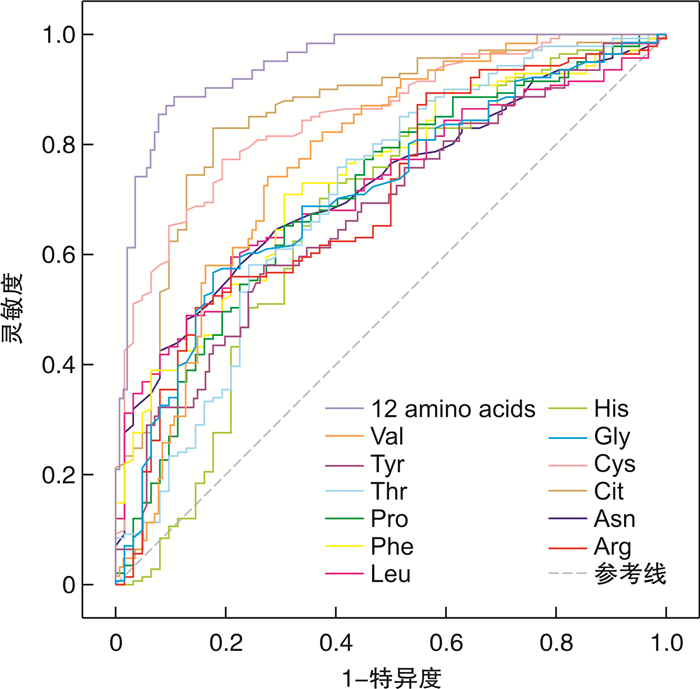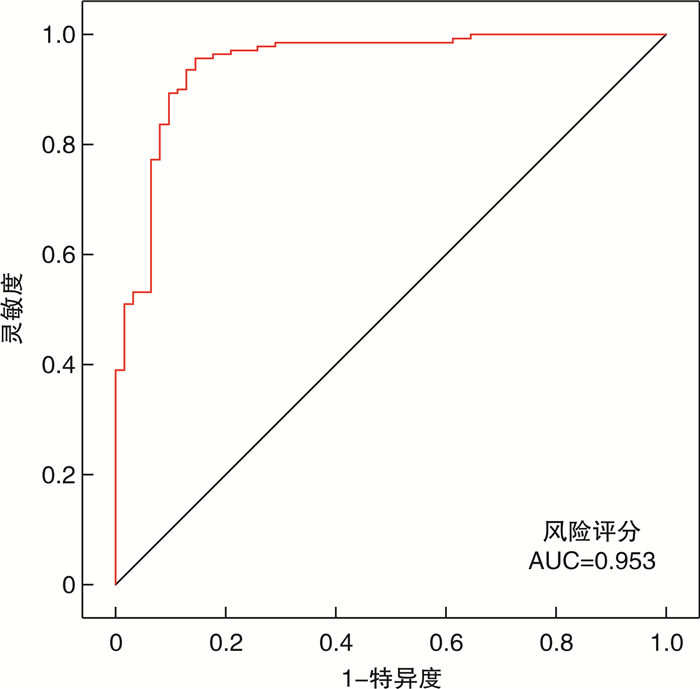Study on the difference and clinical value of serum amino acids in patients with laryngeal squamous cell carcinoma
-
摘要: 目的 检测喉鳞状细胞癌患者与非肿瘤患者外周血清中氨基酸种类及含量差异,探讨他们与喉鳞癌各临床参数之间的关系以及在诊断中的临床价值。方法 采用高效液相色谱-串联质谱(HPLC-MS)法检测锦州医科大学附属第一医院2018年9月-2021年2月初诊的62例喉鳞癌患者(实验组)和同时期的141例非肿瘤患者(对照组)血清22种非必需氨基酸及必需氨基酸种类与含量差异,应用ROC曲线及多元线性逻辑回归模型对差异性氨基酸在喉鳞癌早期诊断中的效能进行分析。结果 实验组较对照组血清中有14种氨基酸含量存在差异,其中13种氨基酸含量显著高于对照组(P < 0.05),包括7种必需氨基酸:苯丙氨酸、苏氨酸、亮氨酸、缬氨酸、组氨酸、酪氨酸、瓜氨酸,以及6种非必需氨基酸:精氨酸、天冬酰胺、半胱氨酸、甘氨酸、鸟氨酸、脯氨酸。而同型半胱氨酸含量明显低于对照组(P=0.024)。进一步分析表明临床早期(Ⅰ期+Ⅱ期)喉鳞癌患者血清中甲硫氨酸含量显著高于临床晚期(Ⅲ期+Ⅳ期)患者(P=0.026)。高分化鳞状细胞癌患者血清中组氨酸含量显著高于低分化鳞状细胞癌患者(P=0.041)。年龄>64岁的喉鳞癌患者血清中天冬酰胺的含量高于≤64岁的喉鳞癌患者(P=0.033),有吸烟史的喉鳞癌患者血清中色氨酸含量均低于无吸烟史患者(P=0.033),有饮酒史的喉鳞癌患者血清中瓜氨酸含量高于无饮酒史的喉鳞癌患者(P=0.003)。ROC曲线分析表明,实验组与对照组间存在差异的14种氨基酸中,除同型半胱氨酸和鸟氨酸不具备统计学意义(P>0.05),瓜氨酸和半胱氨酸作为独立因素诊断喉鳞癌的效能相对较高(AUC数值分别为0.856及0.850);而精氨酸作为单独诊断喉鳞癌因素时的灵敏度则最高(0.855);但单独使用瓜氨酸诊断喉鳞癌时其特异度最高(0.830);将12种氨基酸联合应用于检测可显著提高喉鳞癌的诊断效能,AUC为0.946,灵敏度为0.887,特异度为0.894。基于血清差异氨基酸含量建立多元线性逻辑回归模型的风险评分公式,喉鳞癌组的风险评分高于非肿瘤组(P < 0.001),风险评分诊断喉鳞癌的AUC为0.953(敏感度和特异度分别为0.957和0.855)。结论 喉鳞癌患者与非肿瘤患者比较,14种氨基酸的含量存在差异,其中13种氨基酸的含量在喉鳞癌患者血清中升高,并与年龄、临床分期、病理分化程度、吸烟以及饮酒具有相关性。联合其中12种氨基酸进行检测可提高喉鳞癌的诊断效能,具备外周血辅助诊断喉鳞癌的潜力。同时建立风险评分模型发现其对于喉鳞癌的诊断效能更高,表明该模型对于辅助诊断喉鳞癌有重要潜在价值。
-
关键词:
- 喉鳞状细胞癌 /
- 外周血血清氨基酸 /
- 高效液相色谱-串联质谱 /
- 诊断效能
Abstract: Objective To detect the differences in types and levels of amino acids in the peripheral serum of patients with laryngeal squamous cell carcinoma and non-tumor patients, and explore their relationship with clinical parameters of laryngeal squamous cell carcinoma as well as their clinical value in diagnosis.Methods High-performance liquid chromatography-tandem mass spectrometry(HPLC-MS) was employed to detect the serum amino acid contents and levels of 62 patients diagnosed with laryngeal carcinoma and 141 non-tumor patients at the First Affiliated Hospital of Jinzhou Medical University between September 2018 and February 2021. The study compared the differences in 22 non-essential and essential amino acids found in the serum between the experimental group and the control group. An ROC curve and risk scoring formula of multivariate linear logic regression model was utilized to evaluate the efficiency of serum amino acids in the early diagnosis of laryngeal carcinoma.Results There were significant differences in the contents of fourteen types of amino acids between the experimental and control groups, with thirteen amino acids showing higher levels in the experimental group(P < 0.05). Seven of these amino acids were essential, including phenylalanine, threonine, leucine, valine, histidine, tyrosine, and citrulline. The other six amino acids were non-essential, including arginine, asparagine, cysteine, glycine, ornithine, and proline. Interestingly, the content of homocysteine in the experimental group was lower than that in the control group(P=0.024). Further analysis showed that patients with laryngeal squamous cell carcinoma in TNM stage Ⅰ and Ⅱ had higher serum methionine levels compared to those in stages Ⅲ and Ⅳ(P=0.026). In addition, the content of serum histidine was higher in patients with poorly differentiated squamous cell carcinoma compared to those with well-differentiated squamous cell carcinoma(P=0.041). The level of asparagine in the serum of patients with laryngeal squamous cell carcinoma older than 64 years old was lower than that in patients younger than 64 years old(P=0.033). The level of tryptophan in the serum of patients with a smoking history was lower than that in patients without a smoking history(P=0.033). The level of citrulline in the serum of patients with a history of alcohol consumption was higher than that in patients with no history of alcohol consumption(P=0.003). ROC curve analysis showed that out of the 14 different amino acids between the experimental and control groups, citrulline and cysteine were relatively effective as independent factors in the diagnosis of laryngeal squamous cell carcinoma, with an AUC of 0.856 and 0.850, respectively. Arginine was the most sensitive factor in the diagnosis of laryngeal squamous cell carcinoma(AUC=0.855). However, citrulline alone had the highest specificity(0.830) in the diagnosis of laryngeal squamous cell carcinoma, and the combination of 12 amino acids significantly improved the diagnostic efficiency of laryngeal squamous cell carcinoma, with an AUC of 0.946, sensitivity of 0.887, and specificity of 0.894. A risk score formula for a multivariate logistic regression model was established based on the differential amino acid content in the serum. The risk score of laryngeal squamous cell carcinoma group was higher than that of the non-tumor group(P < 0.001). The AUC of risk score in the diagnosis of laryngeal squamous cell carcinoma was 0.953 with sensitivity and specificity of 0.957 and 0.855.Conclusion This study found that there are differences in the contents of 14 amino acids among which 13 amino acids were increased in serum of patients with laryngeal squamous cell carcinoma, and were associated with age, clinical stage, pathological differentiation, smoking, and drinking. Combined detection of 12 amino acids can improve the diagnostic efficiency of laryngeal squamous cell carcinoma and serve as potential markers for the auxiliary diagnosis of laryngeal squamous cell carcinoma using peripheral blood samples. Additionally, the established risk score model was found to be more effective in the diagnosis of laryngeal squamous cell carcinoma, indicating its important potential value as an auxiliary diagnostic tool. -

-
表 1 实验组与对照组血清中氨基酸含量的比较
μmol/L 序号 氨基酸(AA) 实验组(n=62) 对照组(n=141) t P 1 Pro 399.32±154.50 308.96±109.81 4.741 < 0.001 2 Gly 205.31±83.05 165.47±52.43 4.129 < 0.001 3 Val 135.47±33.91 110.73±28.73 -2.727 0.024 4 Leu 108.94±29.81 90.43±31.15 4.387 < 0.001 5 His 86.55±35.56 71.23±21.20 3.807 < 0.001 6 Asn 82.98±25.93 66.88±24.64 4.218 < 0.001 7 Phe 50.03±20.96 39.38±12.70 4.461 < 0.001 8 Tyr 49.81±17.70 40.77±11.23 4.387 < 0.001 9 Orn 45.37±27.00 38.85±17.93 2.029 0.044 10 Thr 42.80±18.41 33.18±9.20 4.967 < 0.001 11 Cit 26.57±8.76 17.16±5.01 9.678 < 0.001 12 Arg 22.04±18.30 13.68±10.89 4.741 < 0.001 13 Hcy 9.96±1.44 10.34±0.94 -2.272 0.024 14 Cys 1.87±0.88 0.84±0.59 9.795 < 0.001 15 Ala 229.06±90.76 212.85±60.90 1.492 0.137 16 Lys 201.82±70.91 201.70±61.75 0.563 0.990 17 Glu 147.75±45.48 136.34±34.10 1.975 0.051 18 Ser 75.47±43.37 66.82±25.41 1.798 0.077 19 Trp 54.55±15.00 51.05±11.67 1.798 0.074 20 Asp 52.91±27.44 47.95±16.43 1.594 0.112 21 Met 16.21±7.24 14.61±5.89 0.563 0.100 22 Gln 10.71±3.19 10.42±3.41 0.563 0.574 表 2 血清中升高的12种氨基酸单独及联合检测对喉鳞癌的诊断效能评估
序号 氨基酸(AA) AUC 最佳诊断临界值/μmol/L 灵敏度 特异度 1 His 0.661 79.170 0.613 0.730 2 Tyr 0.674 45.560 0.581 0.730 3 Arg 0.703 10.310 0.855 0.504 4 Pro 0.705 318.460 0.694 0.652 5 Thr 0.706 38.815 0.597 0.759 6 Gly 0.711 160.870 0.823 0.574 7 Leu 0.722 88.990 0.790 0.596 8 Asn 0.725 68.970 0.726 0.645 9 Phe 0.736 42.030 0.694 0.709 10 Val 0.772 119.390 0.742 0.723 11 Cys 0.850 1.195 0.806 0.773 12 Cit 0.856 20.320 0.823 0.830 13 12种氨基酸联合 0.946 0.684 0.887 0.894 -
[1] 吴静, 杨睿, 张磊, 等. 基于液相色谱-质谱技术的乳腺癌转移相关代谢标志物的筛选[J]. 天津医药, 2018, 46(10): 1033-1038. https://www.cnki.com.cn/Article/CJFDTOTAL-TJYZ201810002.htm
[2] 吕翔宇, 熊玥, 卢嘉微, 等. 基于液-质联用技术的乳腺癌血清代谢组学分析[J]. 中国医院药学杂志, 2019, 39(16): 1620-1624. https://www.cnki.com.cn/Article/CJFDTOTAL-ZGYZ201916004.htm
[3] Sivanand S, Vander Heiden MG. Emerging Roles for Branched-Chain Amino Acid Metabolism in Cancer[J]. Cancer Cell, 2020, 37(2): 147-156. doi: 10.1016/j.ccell.2019.12.011
[4] Muhammad N, Lee HM, Kim J. Oncology Therapeutics Targeting the Metabolism of Amino Acids[J]. Cells, 2020, 9(8): 1904. doi: 10.3390/cells9081904
[5] Liu J, Wang J, Ma X, et al. Study of the Relationship Between Serum Amino Acid Metabolism and Lymph Node Metastasis in Patients with Colorectal Cancer[J]. Onco Targets Ther, 2020, 13: 10287-10296. doi: 10.2147/OTT.S273107
[6] Ahmed-Salim Y, Galazis N, Bracewell-Milnes T, et al. The application of metabolomics in ovarian cancer management: a systematic review[J]. Int J Gynecol Cancer, 2021, 31(5): 754-774. doi: 10.1136/ijgc-2020-001862
[7] Neef SK, Winter S, Hofmann U, et al. Optimized protocol for metabolomic and lipidomic profiling in formalin-fixed paraffin-embedded kidney tissue by LC-MS[J]. Anal Chim Acta, 2020, 1134: 125-135. doi: 10.1016/j.aca.2020.08.005
[8] Paulusma CC, Lamers WH, Broer S, et al. Amino acid metabolism, transport and signalling in the liver revisited[J]. Biochem Pharmacol, 2022, 201: 115074. doi: 10.1016/j.bcp.2022.115074
[9] Wang H, Jia H, Gao Y, et al. Serum metabolic traits reveal therapeutic toxicities and responses of neoadjuvant chemoradiotherapy in patients with rectal cancer[J]. Nat Commun, 2022, 13(1): 7802. doi: 10.1038/s41467-022-35511-y
[10] 李梦露, 高伟, 吴勇延, 等. 头颈部鳞状细胞癌中肿瘤干细胞生物标记物的研究进展[J]. 临床耳鼻咽喉头颈外科杂志, 2021, 35(9): 854-858. https://lceh.whuhzzs.com/article/doi/10.13201/j.issn.2096-7993.2021.09.020
[11] 吕雅鑫, 陈龙, 蒋义鑫, 等. 淫羊藿苷抑制非小细胞肺癌生长的代谢组学研究[J]. 上海中医药杂志, 2021, 55(6): 84-90. https://www.cnki.com.cn/Article/CJFDTOTAL-SHZZ202106021.htm
[12] 陈君宇, 曹冬焱. 代谢组学在子宫内膜癌中的研究进展[J]. 现代妇产科进展, 2021, 33(9): 1-5. https://www.cnki.com.cn/Article/CJFDTOTAL-XDFC202109015.htm
[13] 许维东, 姚慧韬, 张新平, 等. 基于超高效液相色谱-四级杆静电场轨道阱高分辨质谱技术的曲妥珠单抗辅助治疗人类表皮生长因子受体-2阳性乳腺癌血清代谢组学研究[J]. 中国基层医药, 2021, 28(2): 184-289.
[14] Varghese E, Samuel SM, Líšková A, et al. Targeting Glucose Metabolism to Overcome Resistance to Anticancer Chemotherapy in Breast Cancer[J]. Cancers(Basel), 2020, 12(8): 2252.
[15] Niu F, Yu Y, Li Z, et al. Arginase: An emerging and promising therapeutic target for cancer treatment[J]. Biomed Pharmacother, 2022, 149: 112840. doi: 10.1016/j.biopha.2022.112840
[16] Wu C, You M, Nguyen D, et al. Enhancing the Effect of Tumor Necrosis Factor-Related Apoptosis-Inducing Ligand Signaling and Arginine Deprivation in Melanoma[J]. Int J Mol Sci, 2021, 22(14): 7628. doi: 10.3390/ijms22147628
[17] Harding JJ, Yang TS, Chen YY, et al. Assessment of pegylated arginine deiminase and modified FOLFOX6 in patients with advanced hepatocellular carcinoma: Results of an international, single-arm, phase 2 study[J]. Cancer, 2021, 127(24): 4585-4593. doi: 10.1002/cncr.33870
[18] Wu D, Gong P, Zeng Q, et al. Prognostic implication of proteomic profiles in head and neck squamous cell carcinoma[J]. Clin Chim Acta, 2020, 509: 304-309. doi: 10.1016/j.cca.2020.06.022
[19] 莫海兰, 方红雁, 罗锐, 等. 声带癌前病变术后复发和恶变相关影响因素分析[J]. 临床耳鼻咽喉头颈外科杂志, 2023, 37(5): 354-359. https://lceh.whuhzzs.com/article/doi/10.13201/j.issn.2096-7993.2023.05.007
[20] 费梦佳, 徐雅男, 王家东. 甲状腺乳头状癌与喉鳞状细胞癌代谢组学初步研究[J]. 临床耳鼻咽喉头颈外科杂志, 2017, 31(20): 1561-1565. https://lceh.whuhzzs.com/article/doi/10.13201/j.issn.1001-1781.2017.20.005
[21] Gu F, Derkach A, Freedman ND, et al. Cigarette smoking behaviour and blood metabolomics[J]. Int J Epidemiol, 2016, 45(5): 1421-1432.
[22] 张浩鹏, 王丽华, 郭裕. 天冬酰胺合成酶(ASNS)在喉癌中的表达意义及苦参碱干预机制[J]. 生物技术, 2023, 33(1): 88-94. https://www.cnki.com.cn/Article/CJFDTOTAL-SWJS202301014.htm
[23] 徐娟, 张立庆, 董伟达, 等. 喉鳞状细胞癌术后患者预后列线图的构建和验证[J]. 临床耳鼻咽喉头颈外科杂志, 2022, 36(12): 902-909. https://lceh.whuhzzs.com/article/doi/10.13201/j.issn.2096-7993.2022.12.003
-





 下载:
下载:
